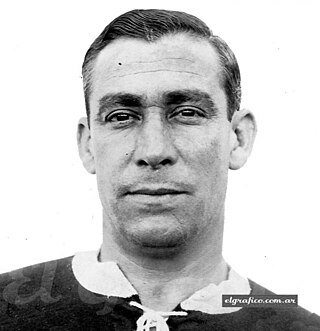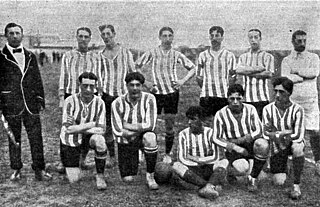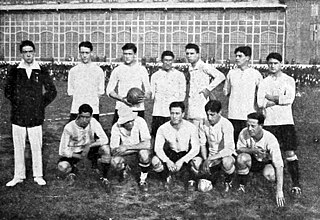
Association football is the most popular sport in Argentina and part of the culture in the country. It is the one with the most players and is the most popular recreational sport, played from childhood into old age. The percentage of Argentines that declare allegiance to an Argentine football club is about 90%.

Club Ferro Carril Oeste, known simply as Ferro Carril Oeste or familiarly, Ferro, is an Argentine sports club from the neighbourhood of Caballito, Buenos Aires. Although many activities are hosted by the club, Ferro is mostly known for its football team, which plays in the Primera Nacional, the second division of the Argentine football league system.
1909 in Argentine football saw Alumni win the championship, their 8th title in 10 seasons. Argentina won all three international trophies contested against Uruguay.
1915 in Argentine football saw the reunification of the Asociación Argentina de Football and the Federación Argentina de Football. Racing won its third consecutive league championship.
1918 in Argentine football saw Racing Club de Avellaneda win its 6th. consecutive league title, remaining unbeaten at the end of the season.
The 1970 Primera División season was the 79th season of top-flight football in Argentina, with Independiente winning the Metropolitano championship by goals for difference (43–42) after being equaled on points with River Plate. In the Nacional championship, Boca Juniors won its 18th league title after beating Rosario Central in the final.
1912 in Argentine football saw the division of Argentine football into two rival associations, when Federación Argentina de Football (FAF) was established to organise its own championships. Thus, Quilmes won the official AFA tournament, while Porteño won the FAF title.
1914 in Argentine football saw Racing Club win its second consecutive Primera División title, apart from winning its second successive Copa Ibarguren. Porteño won the dissident FAF championship, the last tournament before both leagues AFA and FAF reunified. River Plate won domestic Copa de Competencia Jockey Club and international Copa de Honor Cousenier.
1920 in Argentine football saw Boca Juniors retain the "Asociación Argentina de Football" (AFA) league title. In the dissident "Asociación Amateurs de Football" (AAm) River Plate ended the run of seven consecutive league titles for Racing Club de Avellaneda.

Zoilo Canavery was an Uruguayan football player. Born in Montevideo, Canavery was a notable figure of Argentine sport during the 1910 and 1920 decades, playing in four of the "big five" of Argentina, such as Independiente, River Plate, Racing and Boca Juniors.
The Liga Argentina de Football (LAF) was a dissident football association of Argentina that organised its own professional championships from 1931 to 1934. The Argentine Football Association did not recognise those championships until both associations were merged in 1934. Currently all the championships organised by the LAF are considered officials by the AFA.
The 1913 Argentine Primera División was the 22nd season of top-flight football in Argentina. Racing won the official AFA tournament also achieving its first title in Primera División, while Estudiantes (LP) won the FAF title.

The 1912 Copa de Honor Municipalidad de Buenos Aires was the final that decided the champion of the 8th. edition of this National cup of Argentina. In the match, held in Racing Club Stadium in Avellaneda, Racing Club beat reigning champion Newell's Old Boys 3–0, winning its first title in the top division of Argentine football.

The 1913 Copa de Honor Municipalidad de Buenos Aires was the final that decided the champion of the 9th. edition of this National cup of Argentina. In the match, held in Ferro C. Oeste Stadium in Caballito, Buenos Aires, Racing Club beat Club Atlético Estudiantes 5–1, winning its second consecutive Copa de Honor trophy. On the other hand, it was the third and last Copa de Honor final played by Estudiantes, with no success.

The 1917 Copa de Honor Municipalidad de Buenos Aires was the final that decided the champion of the 12th. edition of this National cup of Argentina. In the match, held in Estadio Crucecita in Avellaneda, Racing Club beat River Plate 3–1 in extra time, winning its four Copa de Honor trophy within five years.

The 1915 Copa de Honor Municipalidad de Buenos Aires was the final that decided the champion of the 10th. edition of this National cup of Argentina. In the match, held in Racing Club Stadium in Avellaneda, Racing Club beat Tiro Federal 2–1, winning its third consecutive Copa de Honor trophy.

The 1945 Copa Ramírez Final was the final match to decide the winner of the Copa General Pedro Ramírez, the 3rd edition of this Argentine national cup organised by the AFA. The final was contested by Estudiantes de La Plata and Boca Juniors.

The 1913 Club Atlético Boca Juniors season was the squad's debuting season in Argentine Primera División, the top division of the Argentine league system, after having been promoted by the Argentine Football Association on February 10, along with Banfield, C.A. Comercio, Estudiantil Porteño, Ferrocarril Sud, Olivos, Platense, and Riachuelo.

The 1913 Copa de Competencia Jockey Club was the final that decided the champion of the 7th. edition of this National cup of Argentina. In the match, held in Racing Club Stadium in Avellaneda on 12 October, 1913, San Isidro defeated Racing 2–0, winning their third consecutive title.

The 1915 Copa de Competencia Jockey Club final was the football match that decided the champion of the 9th. edition of this National cup of Argentina. In the match, played at the Porteño Stadium in Palermo on 24 October 1915, Porteño defeated Racing 2–1 to win their first Copa de Competencia trophy.










